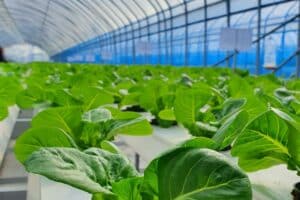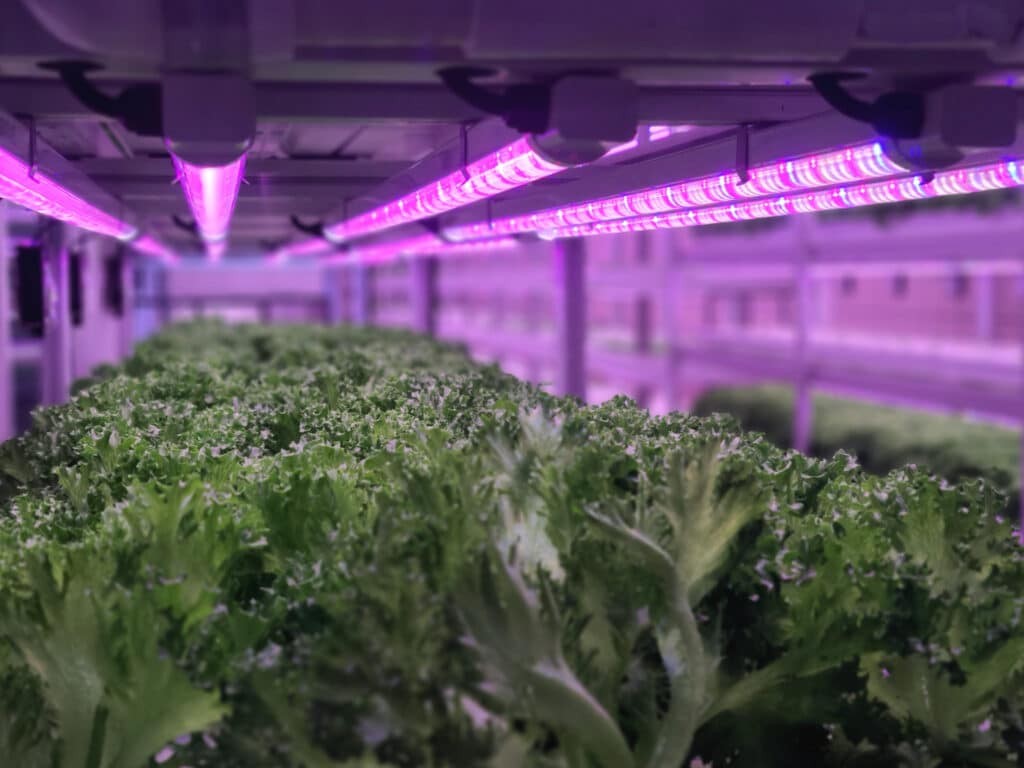Table of Contents
- Introduction
- What is Indoor Vertical Farming?
- How Vertical Farming Helps Food Security
- Why the UAE is Betting Big on Vertical Farming
- Vertical Farming Systems: How They Work
- The Sustainability Factor
- Challenges on the Vertical Horizon
- The Future of Farming
- FAQs
You’ve heard of skyscrapers. Now think of skyscrapers that are growing lettuce.
Indoor vertical farming is a real and rapidly expanding industry, despite its futuristic feel. With land becoming scarcer, population pressures increasing, and climate change unpredictable, perhaps the best course of action is to produce food vertically (as opposed to horizontally).
But is it sustainable? Or does vertical farming just represent a shiny, techy, superficial solution to a far more serious underlying issue?
What is Indoor Vertical Farming?
It is defined by the process of cultivating crops in vertical tiered crop systems in controlled environments like warehouses or shipping containers. Indoor vertical farms use hydroponic, aeroponic, or aquaponic techniques, using LED lights in place of sunlight.

Key features:
- Uses less land
- Can be practiced year-round
- Relies on technology, not weather
- Minimizes transportation (can be set up inside cities)
How Vertical Farming Helps Food Security
Food security is all about access to affordable, safe, and nutritious food. And indoor vertical farming helps check those boxes:
| Problem | Traditional Farming | Vertical Farming Solution |
| Climate risk | Prone to droughts, floods | Controlled indoor climate |
| Land scarcity | Needs vast open land | Uses vertical space |
| Food miles | Grown far from cities | Grown near or within cities |
| Pesticides | Heavy use | Often pesticide-free |
| Seasonal limits | Crop cycles vary | Year-round production |
Vertical farming creates a more resilient food system, removing reliance on weather and global systems, which can be vital during crises such as pandemics or war.
Why the UAE is Betting Big on Vertical Farming
When you think of farming, Dubai’s desert landscape probably isn’t what comes to mind. But that’s exactly why vertical farming in the UAE is such a big deal.
Why it matters:
Government support: The UAE is investing heavily, like the $40 million vertical farm by Emirates Flight Catering.
Water savings: These farms use up to 95% less water, which is crucial in a desert.
Food security: With 90% of food being imported, growing fresh produce locally is no longer optional; it’s urgent.
Vertical farming in Dubai isn’t just smart. It’s necessary.
Vertical Farming Systems: How They Work
Let’s break down the backbone of vertical farming: its systems.
Hydroponics Farming
Hydroponics farming is a term used for growing plants without soil but in nutrient-rich water. The system reuses water in cycles; therefore, there is an excellent reduction in waste.
Aeroponics
Aeroponics is a method of growing plants without soil or water, but by misting the roots with nutrient solution. Aeroponics uses less water and increases plant growth rate compared with the previous methods.
Aquaponics
Aquaponics is a fish-based farming that incorporates hydroponics and aquaponics. Fish waste serves as the nutrient soil for the plants; thus, plants clean the wastewater.
The Sustainability Factor
Now, to the million-dollar question: Is indoor vertical farming truly sustainable?
The Pros
- Saves water (up to 90-95% less than traditional farming)
- Reduces carbon footprint (less transportation)
- No soil degradation or deforestation
- Low pesticide usage
The Cons
- High energy usage, especially for artificial lighting and climate control
- Cost of infrastructure and tech maintenance
- Limited crop diversity is great for leafy greens, not so much for grains
So, is it 100% eco-perfect? Not quite. But as renewable energy sources become more common, vertical farming’s sustainability score is improving.
Challenges of Vertical Farming
Despite the hype, vertical farming faces some serious speed bumps:
- High setup and maintenance costs
- Energy consumption, though solar integration is growing
- Market readiness, not every consumer is sold on hydroponic lettuce
- Skilled workforce needed for tech-based operations
The Future of Farming
Although this method of farming might not be the answer to all of our food issues right away, it is a fantastic way to supplement conventional farming, particularly in areas with little land or severe weather. The cost and energy efficiency of contemporary vertical farming systems are increasing. Cities from Toronto to Tokyo, as well as high-tech locations like Dubai, are beginning to depend on these farms. They are contributing to the development of a more sustainable and safe method of growing food near people’s homes.
FAQs
1. Is vertical farming profitable?
It can be lucrative, especially if you are cultivating valuable crops like leafy greens and herbs. However, it is contingent upon a number of variables, including the crop being grown, the location of the farm, the size of the farm operation, and the energy expenditures.
2. Which crops thrive in vertical farms that are indoors?
Crops that develop quickly and require little space are used in vertical farms. Leafy greens like kale, spinach, and lettuce as well as herbs like basil and mint are examples of these crops. These crops thrive in regulated settings and work well in stacked growing systems.
3. Why is vertical farming important in regards to the UAE?
Vertical farming is important in terms of the UAE for many reasons. It provides less actual food importation, reduces water use, and assists with food security in an extreme environment with limited land for agricultural match.

Pingback: Why Has Vertical Farming Recently Become More Economical? – Skyfield Agritech
Pingback: LED Growlights vs Sunlight: Best Choice for Vertical Farming